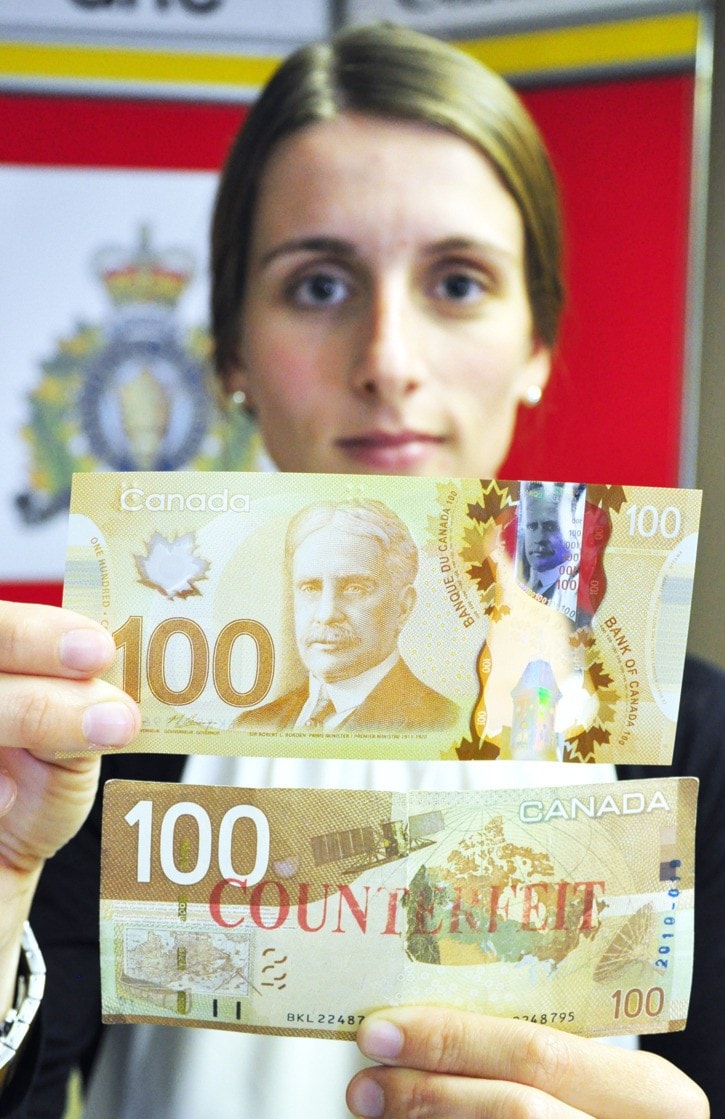Canadian currency counterfeiters may have met their match.
The Bank of Canada is rolling out high-tech plastic polymer bills fused with transparent windows and embedded with shimmering metallic images. For those in the business of trying to print their own cash, high-bond paper and an inkjet printer definitely won’t cut it anymore.
“There are 30 countries in the world using polymer,” said Isabelle Jacques, a Bank of Canada currency analyst, during an information session at the West Shore RCMP station. “This is the best bank note for Canada, the most advanced that’s ever been produced, and one of the best in the world.”
Banks will start circulating polymer $100 bills in November, $50s by March 2012, and $5, $10 and $20 bills by late 2013. Holding a crisp new $100, Jacques pointed to the long transparent window framing a metallic portrait of Robert Borden, Canada’s prime minister through the First World War.
“(A window) so large with the metallic stripe has never been done before. It is state of the art,” Jacques said. The second smaller maple-leaf shaped window has a tiny number embedded, visible only under direct light and close to the eye.
At 19 cents apiece, the new bills cost almost double to manufacture and print, but they are expected to last 2.5 times longer. Cotton-based bills in circulation now last about three years. Durable polymer versions are expected to last 7.5 years, based on evidence from other countries.
“In the long run we are going to save on production costs and transportation costs, estimated at $200 million we are going to save with the new series,” Jacques said.
And unlike current cotton-based notes which are shredded and sent to the landfill at the end of their lives, polymer material can be recycled.
The Bank of Canada expects the new bills to be extremely tough to copy and easy for people to spot a real from a fake. Counterfeiting Canadian currency has been on a steady decline since a peak in 2004, when the current, more secure series was introduced.
Where six years ago merchants were passed more than 550,000 fake bills, last year about 53,000 counterfeits were removed from circulation – the majority being $20s and $100s printed with an inkjet-type copier. Of those, 39 per cent were seized in B.C., the most of any province.
Last year, West Shore RCMP had 49 cases involving suspected counterfeit currency, mostly with merchants who were passed fake bills. In one investigation, West Shore Mounties seized three fake $100s from a pre-2004 series and sheets of textured paper bearing attempts to replicate $20 and $50 bills.
Jacques stressed that it's a myth that larger denominations, such as $100s, are more likely to be counterfeit. Merchants who only scrutinize $100 bills leave themselves open to fraud.
“People should not think (counterfeiting) is just big denominations. The security features from the $5s to the $100s are the same,” she said. “In 2007, $5s $10s and $20s were 90 per cent of all counterfeit bills.”
“From our investigations we’ve seen all denominations of currency, and U.S. currency as well. It's not just $100 bills." said RCMP Cpl. Kathy Rochlitz said. “Ultimately the public is are our eyes and ears. They are the first line of receiving that bill and notifying us it’s out there. It does happen in our community.”
The West Shore RCMP community policing section is willing to hold information sessions with merchants on spotting real bills from fakes. Call community policing at 250-391-3327.
For more on Canada’s high-tech currency, see www.bankofcanada.ca, under “Bank Notes.”
editor@goldstreamgazette.com
